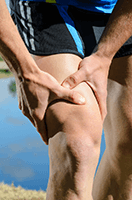Trigger points
 Trigger points are described as a tender spot in a tight band of muscle, that is painful on palpation or touch. They are commonly called “knots” and may cause pain locally, may refer pain to a different area of the body or may limit range of motion. They are caused by overactivity in a muscle, which may be a result of the likes of poor posture, muscle imbalances, overuse in sport or daily activities, or stress. Read more
Trigger points are described as a tender spot in a tight band of muscle, that is painful on palpation or touch. They are commonly called “knots” and may cause pain locally, may refer pain to a different area of the body or may limit range of motion. They are caused by overactivity in a muscle, which may be a result of the likes of poor posture, muscle imbalances, overuse in sport or daily activities, or stress. Read more

 Have you been experiencing pain along the arch of your foot near the base of heel? Do you feel like you have a bruise on the pad of your heel?
Have you been experiencing pain along the arch of your foot near the base of heel? Do you feel like you have a bruise on the pad of your heel? Quadriceps contusion or “cork thigh” is the result of a severe impact to the thigh, often causing deep rupture to the muscle tissue and bleeding occurs, followed by inflammation.
Quadriceps contusion or “cork thigh” is the result of a severe impact to the thigh, often causing deep rupture to the muscle tissue and bleeding occurs, followed by inflammation. Femoroacetabular impingement (FAI) is a condition where the two bones of the hip are abnormally shaped, hence do not fit together properly, causing the two bones to rub against each other and cause damage to the joint.
Femoroacetabular impingement (FAI) is a condition where the two bones of the hip are abnormally shaped, hence do not fit together properly, causing the two bones to rub against each other and cause damage to the joint. A stress fracture is a tiny crack in a weight bearing bone. It can occur in any part of the body but predominantly occur in the lower leg or feet.
A stress fracture is a tiny crack in a weight bearing bone. It can occur in any part of the body but predominantly occur in the lower leg or feet. A direct blow to the chest or to the ribs themselves may cause the ribs to bruise, break or separate from the breastbone. Whilst bruised ribs are extremely painful, in most cases they heal completely. The injury is referred to as bruised ribs but majority of the pain is caused by injury to the surrounding muscle and rib cartilage.
A direct blow to the chest or to the ribs themselves may cause the ribs to bruise, break or separate from the breastbone. Whilst bruised ribs are extremely painful, in most cases they heal completely. The injury is referred to as bruised ribs but majority of the pain is caused by injury to the surrounding muscle and rib cartilage.